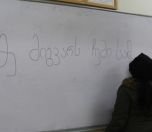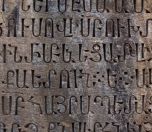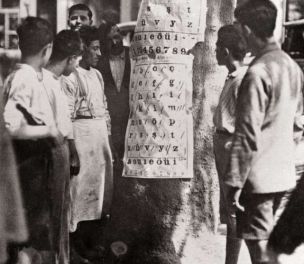Click to read the article in Turkish
The Laz language, spoken in the far east part of the East Blacksea region of Turkey, continued to exist in this region for thousands of years. This region which starts from the Pazar district of Rize and reaches up to the border with Georgia is divided in between by deep valleys and rivers flowing from the mountains to the Blacksea and it was called Lazia in the past and Lazistan later on.
With villages distributed throughout the steep valleys with pieces of arid and scant lands, and small fishing towns around a few shops named "noga" this region could never produce sufficient wealth from agriculture or trade to bring prosperity to its people. This has caused the people in the region to migrate to large cities, mostly to İstanbul.
Bizantologue Antony Bryer who studied the Laz history describes this situation briefly saying, "The fate of the Laz people was determined by the geography of their country. Lazistan mountains, allowed them to protect their independence on the one hand, but prevented them from developing further in agriculture or pursuing a more developed policy."
Two Lazistans
The Lazistan region was divided into two following the "93 War" between the Ottoman and Russia. The Ottoman Lazistan included Atina (Pazar district of Rize including Ardeşen), Viche (Fındıklı), Arhavi, and the region till the Kopmuş headland in Hopa, while the Lazistan in Russie included Makriyali (today the area between Kemalpaşa and Sarp), Çxala and Beğlevan (the area around the Düzköy and Güreşen villages of Borça). After the 93 War two-thirds of the people of the region left for Russia and migrated from the lands of their ancestors to Western Anatolia and especially to Sapanca, Düzce, and Yalova in the Marmara region.
After the October Revolution in 1917, the two Lazistans re-united with only a small part left outside. The border was set to be a river passing from inside the Sarp village. Half of the Sarp village, therefore, remained under Soviet administration.
As a result of this, the Laz intellectuals were active in two cities, either in İstanbul which was under Ottoman rule, or in Batum which was first under the rule of Czarist Russia, then Great Britain, and then the Soviet Union.
İstanbul was the educational, cultural, and political center of the Laz people who were under Ottoman rule, just like the other people within the Ottoman state. Laz youth were receiving education and meeting new ideas, and different cultures here. In the first years of the rule of the Committee of Union and Progress (İttihat ve Terakki Cemiyeti), the Laz Students Committee was founded in 1914 and the Laz National Development and Auspice in 1019 by the Laz intellectuals in İstanbul.
These organizations founded in-between both national and international political upheavals and in the shade of the First World War could only exist for a short period of time and include a small circle of people, but they became history shortly after with the very quickly changing political atmosphere. These intellectuals, who could have ignited a Laz national awakening, participated in the movement in Anatolia and played a role in the establishment of the Republic. One example is Hüseyin Hüsnü Çakır, the founding president of the Laz Students Committee who would later become the Defence Minister in the Republican period.
İstanbul Laz movement first became pro-Ottoman and then republican, but the Laz people around Batum were for independence.
In 1919, they founded the Lazistan Freedom Committee (Lazistan Tahlisi Cemiyeti) and tried to organize around the slogan "Lazistan belongs to the Laz people." The successors of this group published the first newspaper in Laz language in 1929. However, the Turkey-Soviet Union relations turned the border into an iron curtain, and their relations with the Laz people in Turkey almost totally broken down. But the Laz movement did not fade out in Russia, the Laz people who were on this side of the border organized and the Laz Cultural Autonomy process was experienced at the beginning of the 1930s.
Many first steps for the Laz language and culture, such as the opening of the first Laz schools, preparation of the school books in the Laz language, and establishment of the Laz alphabet commission and the Red Lazistan Colhoz all took place led by İskender Tzitaşi. This process continued until the Great Purge years in 1938 and ended with the execution of Tzitaşi, all Laz villages except for Sarp were exiled to Middle Asia in 1944, and studies on the Laz culture and language in the Soviet Union were left to Georgian Nationalist factions.
Three lost generations
While this advance and then the sad decline was being experienced in the Soviet Union, in Turkey the Republic was proclaimed, and the construction of the Turkish nation started. There was no permission for any organization in relation to the Laz people. People who may have established such organizations were oppressed and purged at the very beginning of the Republic, and a sense of belonging to any group other than Turks was regarded as a reason to be disapproved of or humiliated, to say the least. Such ideas were identified as divisive or betrayal.
The young Republic had a Turkish national character inherited from the Party of Union and Progress (İttihat ve Terakki) which could sometimes go to extremes and being a member of another nation by ethnic origin, or using a traditional language other than Turkish was being blown on. The young Republic rejected any ethnic unit other than Turkish and took its chances with denial and assimilation. It has been successful to an extent.
Until 1993, in a period of 70 years covering three generations, there has not been a single work, not one line of written work in the Laz language, about the Laz culture, policy, and identity in Turkey. For many years there have been only some texts written, such as those by Fahrettin Kırzıoğlu, that try to show the Laz people as a Turkic tribe, but nothing else about the Laz people.
From Germany to Turkey
Wolfgang Feurstein, who visited the East Blacksea region villages for preparing a report as a student about the newly developing tea trade in Turkey in the 1970s was very interested in the Laz culture that he met here and dedicated almost all his life to Laz studied.
He brought together the few Laz people in Germany who had gone there as workers and played the leading role in the re-establishment of the Laz language alphabet in 1984. This alphabet which was well-received among the Laz people of Turkey is still being used.
The "Lazuri alphabet" book that Feurstain published in 1984 was the first school book published after "Okitxuşeni Supara" published in 1936 in the USSR. We can say that the long period of decline ended with this book. In 1991, another alphabet book was published named "Nananena" (Mother tongue) and books started to be published in Turkey from 1993 on.
"The Laz Renaissance"
We can say that a "Cultural Renaissance" was experienced, again among the Laz people living in İstanbul, in 1993 and the years that followed, together with developments such as the dissolution of the Soviet Union, the liberal policies of the Turgut Özal period in Turkey,
The Laz people who came together in 1993, started publishing the first bilingual magazine in Laz language and Turkish, named Ogni. This was the first periodic publication of the Laz people in Turkey. Six issues of this magazine were published until 1996, the first of which was recalled. The publishers stood trial at the State Security Court but were acquitted.
The movement, centered in İstanbul and among a limited number of people, focusing on the mother tongue, continues taking cautious steps. The first books and dictionaries are published in the Laz language at the end of the 90s. The Laz music becomes very popular with the albums of the Zuğaşi Berepe band and Birol Topaloğlu. Ogni magazine which was closed continues with the Mjora andSkani Nena magazines.
Laz Cultural Movements starts to establish its institutions in the 2000s. Sima Foundation and Gola Association are founded. The Laz Culture Association follows them in 2008, and the Laz Institute in 2013.
Again in this period, Laz language courses start to be given in some private institutions and in associations. Kazım Koyuncu, who passed away at a young age from cancer, helps the Laz language be brought to the agenda in Turkey, with his songs.
When the state-run television TRT takes a decision to broadcast in Kurdish, an application is made for broadcasting in the Laz language. However, with no outcome. Applicants also go to court, over the principle of equality but the case closes with a response given, which shortly means that "the state does not have such an obligation." The same attitude continues when Kurdish and Zaza language departments are established at universities. The request made for a Laz language department to be established at the Rize University is rejected, stating that the Laz language does not have its historical, philological texts.
Rise of the social media
Social media networks started to establish at the beginning of the 2000s. Interaction starts among a larger mass of people than that the published media had gathered on the forums of websites such as lazuri.com, lazebura.com, and kolkhoba.com between the Laz people of various tendencies. Platforms such as Facebook, and Instagram follow these. Village groups, district groups, and Laz language groups on these platforms carry the Laz cultural movement which is İstanbul centered and among a limited group of people, to the villages and towns. Many new people take initiative and participate through social media. Production in Laz language increases with social media, stories, and poems start to be published in these groups, and pages. New authors emerge who write in the Laz language. Today most of the content produced and intervention made in the Laz language is on social media.
Laz language in public schools
We can talk about the presence of Laz language courses since the beginning of the 2000s opened by left NGOs and initiatives centered in İstanbul. However, Laz language education was carried out more seriously with the Laz language courses opened at the Bosphorus University in the 2011-2012 academic year. This enabled many theses to be written in the Laz language at this university. Courses at Bilgi University followed those at Bosphorus University.
But 2012 was the important year for education in the Laz language. The then Prime Minister Recep Tayyip Erdoğan announced on June 12, 2012, that the students would be able to learn local languages and dialects when talking about the novelties brought with the 4+4+4 education system.
Erdoğan said, "It will be possible to take Kurdish as an elective course if there are the required number of students," and announced the Living Languages and Dialects lessons. The following day, the then Minister of Education Ömer Dinçer announced that package of courses. Dinçer said, "As long as there are teachers, and the required number of students, Zaza language, Kurdish, Laz language, and Abkhazian will be the elective courses. First, the curriculum will be prepared and the books will be published later.
Although the lessons started in 2014 because the curriculum was not ready before, the Republic of Turkey has recognized the Laz language in its 90th year and allowed it to be taught in middle schools affiliated with the Ministry of Education.
Beyond doubt, it is a significant and valuable achievement that the Laz language started to be taught at schools. The subscription has been comparatively good in the first years with the efforts of the Laz activists and especially the teachers but it could not be sustained. We can see that this is not specific to the Laz language but that the other languages also face problems related to continuity. The most important factor is that the courses are not satisfactory in terms of curriculum, teachers, and education materials, that they are not sufficiently encouraged, and that school managements are canalizing the students to other elective courses.
Anticipated future
The Laz language has never been spoken by a large population in any period of history that we know, and it has not been the language of the market or a religion. We do not have any proof of the Laz language being written before 1795. But despite all these, it was never lost neither during the Byzantine nor the Ottoman Empires, it was preserved until today. It was a very lively language until the 1980s, and in those years many children heard Turkish for the first time when they went to school. However, when electricity and then televisions entered our houses in 80s, the Laz language started to come second in our houses.
When above this, all problems, and failures in education were associated with speaking the Laz language, and when education was built on "not speaking the Laz language," the last 40 years pushed the Laz language to the edge of a cliff. Even if we do not have a figure at our hands, the number of children under 10 who speak the Laz language should be less than five percent of the total population. Unfortunately, the parents do not teach their children the Laz language. This means that there will not be any Laz language speakers after several generations if there is no intervention.
Today, there is this extinction that approaches on one side, and the Laz language attracts attention that it never has before both with its published materials and social media content. Not only in İstanbul but in the districts, neighborhoods, and villages where the Laz language is spoken, people are trying to do something about their mother tongue, each in their unique way, with strong participation by women. The Laz language has officially been recognized in Turkey for the first time, we now have the term "the Laz language teacher" in the country. The next stage should be the opening of a TV and a university department in the Laz language with the help of a strong campaign. The Laz language is living its golden age, however, this is similar to the light coming from a dying star, it is also a sign that ill fortune is approaching.
Can we return from here? There are many examples, we can. This requires that the future of the Laz language should be planned and this can only be done by an institution that is politically and financially strong and by means of positive discrimination.
(İÇA/AÖ/PE)
İrfan Ç. Aleksiva




.jpg)


.jpg)
sasa.jpg)
